Best Smart Lights – Our Top Picks And Buyer’s Guide
Smart lights can help reinforce the natural sleep-wake cycle, increase the security and safety of your home and help you save money on utility bills.
Smart lights can help reinforce the natural sleep-wake cycle, increase the security and safety of your home and help you save money on utility bills.
The utilization of smart home gadgets has seen a notable increase in recent years. Smart lighting systems are beneficial in lowering your monthly utility bills, aiding your natural sleep-wake cycle, and improving your home’s security and safety.
The light plays a vital role in the synthesis of a body’s natural sleep hormone – melatonin. Artificial light can negatively affect your sleep, that’s why smart lights try and help your natural daily rhythm. They use bluish white light in the morning to help you wake up, brighter white light during the day, so you stay energized, and warmer yellowish and red tones that signal your brain that it is time to relax and fall asleep.
Smart lights cost between $20 to $60 per light bulb, which is more than your typical LED light, but they offer so much more, and the energy they save on your monthly utility bills will make them worth it in the long run.
Read on if you want to learn about some of the best smart lights on the market, as well as to see what you need to consider when buying them.
Highlights:
We chose LIFX Mini Day & Dusk because of its particular focus on sleep. These smart light bulbs are designed to imitate natural sunlight, thus making it easier to fall asleep and get up in the morning. The circadian rhythms are essential for your everyday life, and that’s why the LINX app will adjust the temperature and light settings based on your daily routines, to help reinforce them.
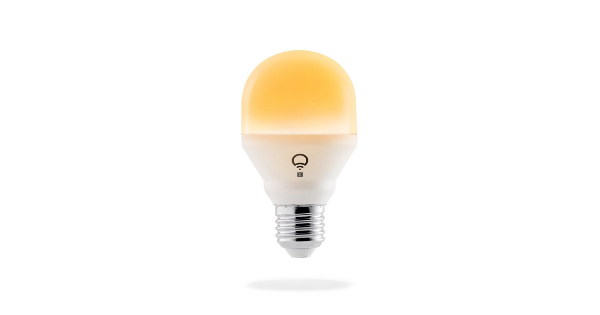
You’ll wake up to cool shades of white in the morning, bright light will slowly intensify during the day to keep you energized, and then it will introduce you to warmer shades of white, to help you relax before going to bed.
The LIFX Mini Day & Dusk Smart Light Bulbs are so easy to use, once you screw them in they are pretty much ready. The best part about LIFX Mini smart bulbs is that there is no Hub involved, so the only thing you need to do is to download an app and set everything the way you want. The app is available for Android and IOS, as well as Windows 10. The app is so easy to use, you can set up scenes or choose from the pre-made ones, set individual timers and schedules and group the lights you want to work together.
The Linx Mini smart bulbs are incredibly durable and will make you save money on your electricity bill in the long run. If you want to save up when buying them, you can get them in packs of four, for a better price.
Highlights:
The Philips Hue White and Color Ambiance is compatible with pretty much all of the home automatization systems and can make your life a lot easier.
The Philips Hue Starter Kit is easy to set up. You screw in the smart light bulbs the way you would screw in the traditional ones, turn on the included Hue Hub and download the Hue mobile app. Take note that for the smart lights to work, they need the Hue Hub, so that’s another physical device in your home. The Hue app is simple to use, and it will walk you through all the settings, setting up scenes, schedules, and pairing your hub with the other smart home devices.
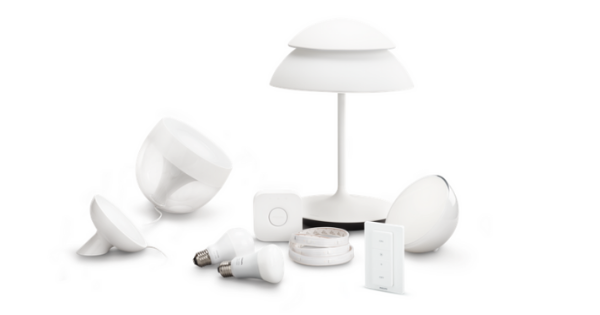
There are 16 million colors to choose from, including 50 thousand whites, so you’ll surely find the perfect lighting for your home. The manufacturer paid particular attention to the blues and greens, so they are incredibly satisfying. You’ll be able to pick the colors and set the scenes using your smartphone or a tablet, and if you pair up your Hue Hub with your smart home system, you’ll also be able to change the settings with voice commands.
The Philips Hue app has some fantastic features such as 30 pre-set scenes designed to mimic sunsets and other nature scenes, so that it will help you fall asleep faster, relax better or wake up more relaxed in the morning. There are also scenes for reading, watching movies and many other things that you’ll find useful.
The Philips Hue Starter Kit also has excellent durability and is very energy conserving, so it will help you save money on your electricity bills in the long run.
Highlights:
The Sengled Element Classic smart light bulbs are one of the most affordable options on the market. They come with the Sengled Element Classic Hub that can control up to 64 smart bulbs in your home. The setup is easy, and you’ll find an app where intuitive to use as well.
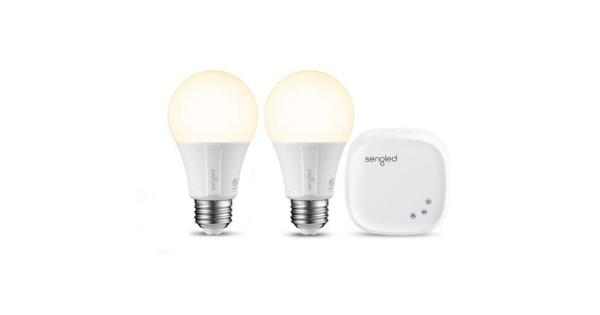
The Sengled Home App is available for IOS and Android. You can easily control your lights via the app, and it also has pre-programmed Wake-up and Bedtime settings, so you don’t have to do it yourself. Just set the desired time when you want them to begin, and the app will do the rest. The Energy saving mode will automatically turn the lights off or dim them when you don’t need them.
While this is one of the most affordable options, there are also a few downsides. You can’t program the scenes to your liking, and the Sengled Element Classic is also compatible with fewer smart home systems. However, the company claims they are working on making the Hub compatible with Apple HomeKit.
Highlights:
The Sylvania Smart Home light bulbs offer that retro look while having a functionality of the smart technology. These vintage-looking smart bulbs can be connected via Bluetooth with your Apple HomeKit, so you’ll be able to turn the lights on and off, dim them, or put on some of the programmed scenes, all with voice commands.
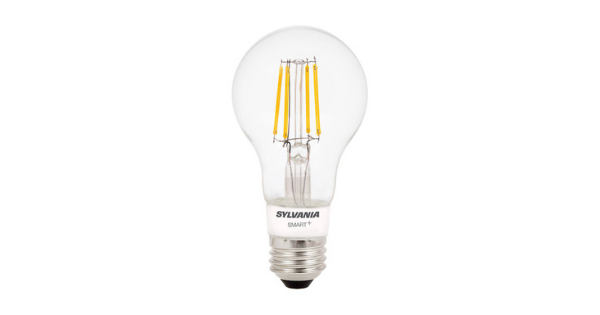
You can set timers, program scenes for any occasion without the need of a Hub. You don’t even need the internet, as you can connect them via Bluetooth and use Siri to change the settings. However, you can’t control them when you are out of the Bluetooth range.
The Sylvania lights have shorter durability and can only be connected via Bluetooth to your Apple devices, that’s why the price is on the lower side.
Highlights:
The Philips Hue Go Smart Light Table Lamp has all the features of previously reviewed Philips Hue smart light bulbs with an extra addition; it is portable so you can take it anywhere with you. The curved design is pretty neat, and it will fit well in any surroundings. With a diameter of 6.5 inches, it won’t take much space, and you can always bring it with you when you’re traveling.
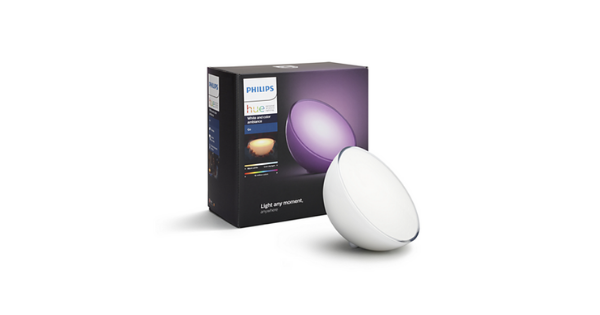
When you are at home, the Philips Hue Go will work as a part of your home lighting system. When traveling, you can use its features to help you fall asleep easier; there is even a candlelight setting for when you’re camping.
The Philips Hue Go can be used manually to adjust the color, the brightness and the temperature of the lamp, but it works best with a Hue Hub. It is sold separately, but it will be worth it because of all of the great features you’ll be able to use with it.
The main advantage of smart lights is that you don’t have to get up and turn the switch off. You can do so from the comfort of your bed by giving a simple voice command, or by using your smartphone app. There are many features and types of smart light bulbs on the market, so here are some things to consider:
Connectivity: Smart lights use WiFi or Bluetooth to connect to your smartphone, tablet or an automatization home system. Some need an additional Hub to interface between smart light bulbs and the app.
Compatible systems: Many smart bulbs are compatible with home systems such as Amazon Alexa, Apple HomeKit, Samsung SmartThings, Google Home, Xfinity and many more.
Mobile app: You can use the app to configure your smart lights, group them, set different scene programmes, and schedules, such as dimming or turning off when going to bed.
Voice commands: Most models have voice commands that you can use to turn the lights on and off, change the color, brightness, and temperature, or pick one of the pre-made ambient scenes.
Color: Smart light bulbs come in full color, soft white or bright white. Full-color ones include as much as 16 million colors.
Size: They come in all sizes that your home may need; floor and table lamps, light strips, ceiling lights, and other. Most bulbs are equivalent to 60 watt LED lights.
Scheduling: You can set smart light bulbs to follow a predetermined schedule. For instance, you can set them to turn off every day when you go to work. Some people worry about the safety of their homes when they are away for a vacation or extended period. You can make a schedule, so your lights periodically turn on and off, making it look like somebody is at home.
Sleep/wake: Some smart lights have a pre-programmed wake-up and bedtime schedules, so all you need to do is set the desired time for you to wake up or go to sleep. With some, you can even make a customized schedule for yourself. Usually, warmer tones and dimmer lights turn on at night, to help you relax and fall asleep faster. In the morning, brighter cooler lights help you get up, and feel well rested, while bright lights keep you energized during the day.
Scene programming: You can set special light ambients to match different parts of your day, like watching movies, reading, and relaxing.
Motion sensor: Smart light bulbs use GPS technology in your phone to determine where you are in your home, and they’ll turn on and off depending on your position.
Home safety: You can connect your lights with a smoke or security alarm, so that they start blinking when one of them is triggered, making it easier for you to notice.
Price: Smart light bulbs usually cost between $20 and $60 each, considerably more than your standard LED light bulb. However, they use energy more efficiently by turning on and off, so you’ll save money in the long run.
Brand: Keep in mind that most non-brand smart light bulbs won’t work with the brand ones, so if you have decided to get smart lights in your home, the best would be to pick a brand and stick with it.
Dusan is a biologist, a science enthusiast and a huge nature lover. He loves to keep up to date with all the new research and write accurate science-based articles. When he’s not writing or reading, you can find him in the kitchen, trying out new delicious recipes; out in the wild, enjoying the nature or sleeping in his bed.